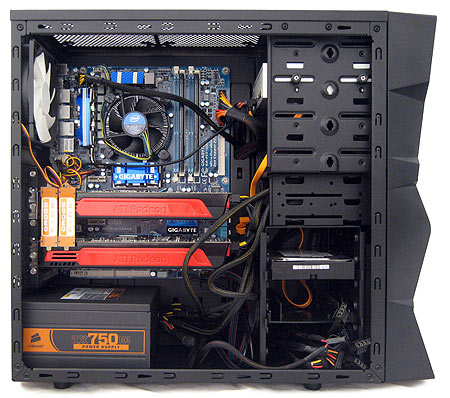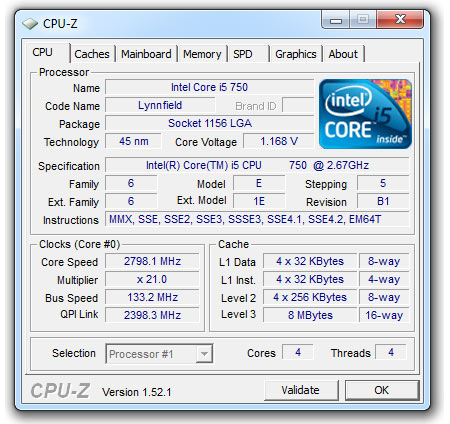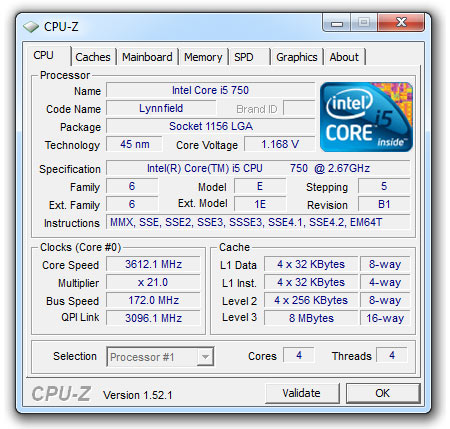System Builder Marathon, Dec. 2009: $1,300 Enthusiast PC
Assembly And Overclocking
This system was very straightforward to assemble. The NZXT M59 affords a lot of space for the price, and even the fairly large Radeon HD 5850 cards slipped into the Gigabyte motherboard with ease. The case also offered a reasonable amount of space for cable management. The result, pleasantly, was a quick setup.
Overclocking
First off, we think it's important to mention that for all intents and purposes, our Core i5-750 CPU is a 2.8 GHz part, even though it is advertised as a 2.66 GHz CPU. This is because it constantly ran a turbo multiplier of 21x for a 2,793 MHz clock speed even when all four CPU cores were stressed. The higher speed can be attributed to the processor's Turbo Boost settings, and so long as you're able to keep the CPU within its thermal/power bounds, it'll run at 2.8 GHz all day long.
Overclocking the Core i5-750 without the budget to afford a good aftermarket cooler is an exercise in temperature control. Unlike most overclocking experiences we've had in the past, we found that this CPU was so eager to overclock with stock voltage that it quickly reached 100 degrees Celsius when set to a relatively mild 3.6 GHz speed. The CPU had legs to go much further, but we pulled back considering, what those temperatures can do to hardware. We wanted a real-world overclock that wouldn't melt the box after a month of use.
Since our nemesis was temperature and not a CPU limitation, we actually “under-volted” the processor in order to reduce heat. With the CPU reduced to 1.15V from the stock 1.25V setting, we were able to keep our 3,612 MHz overclock without breaking the temperature barrier during Prime95 runs.
The fact that the CPU was willing to clock this high while under-volted really speaks to its potential for a much higher overclock with proper cooling, but we'll have to leave that to the lucky winner of the contest for this machine.
As we've mentioned previously, we'll first run our factory-overclocked XFX Radeon HD 5850s at reference speeds to simulate a garden-variety model of the cards that would fit within our budget. To get the overclocked numbers, we've pushed the speed as far as the BIOS will allow to 775 MHz core/1,125 MHz memory. This is ludicrously close to the factory overclock of 765 MHz core/1,125 MHz memory with which this overclocked edition card comes, so the overclock very closely represents what the XFX Radeon HD 5850 Black Edition is like in stock form.
Get Tom's Hardware's best news and in-depth reviews, straight to your inbox.
Current page: Assembly And Overclocking
Prev Page Memory, Hard Drive, And Optical Drive Next Page Test System And BenchmarksDon Woligroski was a former senior hardware editor for Tom's Hardware. He has covered a wide range of PC hardware topics, including CPUs, GPUs, system building, and emerging technologies.
-
Crashman Great build Don! The only thing I'd change is to use the RAM from the $2500 system! It's too bad you didn't have enough money left over to buy a big cooler.Reply -
noob2222 Very smoothe build, pretty limited with the 5850s with the pricing once past that, but this thing handles it well, esp since the cpu was lucky enough to stay fast while undervolted.Reply
Not all cpus are the same, this one compared to the $2500 build definatly shows it. Takes a bit of luck sometimes or bad luck. -
Tridec Just a thought, but why not use an I7 920 CPU, with an asrock x58 Extreme motherboard? I see a lot of people bought their I7 920 CPU for 199 dollars and the motherboard costs 170 dollars.Reply
Pair that up with OCZ 1333 platinum 7-7-7-24 memory, that can easily be overclocked to 1600 7-7-7-24 and you'll have a powerful system with 36 PCI-e lanes and loads of CPU overclocking room thanks to asrock's great motherboard. -
SpadeM Good article, and yes the quadfire setup was sweet back then!! I just have a question/suggestion to make, and if you find worthy of a replay I'd much appreciate it.Reply
Since you are willing to experiment with different setups, and since we see the problem with the Phenom in the application suite, why not try something more exotic like pairing a nvidia based card with the crossfire cards to act like a PPU / video transcoding accelerator (TMPEng supports CUDA at least to act as a filter). I don't know if this makes sense in a marathon build, but I'd like to see something like this benchmarked.
-
shubham1401 This is an excellent build.Reply
With an aftermarket cooler this build will be flawless.
Power Draw,Performance all were nice.
The case looks nice too. -
burnley14 I'm not especially interested in the gaming results per se, but this build certainly solidifies my choice to go with an Intel processor over AMD based on productivity benchmarks.Reply -
optional22 Aside from the video cards, this is essentially the same build as the $2,500 build recently posted performance-wise. What is the point?Reply -
kick_pixels Good system over all… an extra hard drive for backup is essential and the wiring needs some tiding up.Reply
-
cangelini More specifically, these guys are trying different things each time we do a round of SBMs--sometimes the results are great, and sometimes they're not as good. The point is that we're putting the machines together and reporting on the results so that you can decide if you want to do the same or not. And hopefully, when we come across a result that doesn't look so hot, we'll call out where our mistake was in building the box.Reply
Just think how boring these would be if every quarter we did a Core i7-920-based machine at $2,500, a Core i5-750 machine at $1,500, and a Phenom II-based box at $700! =)




